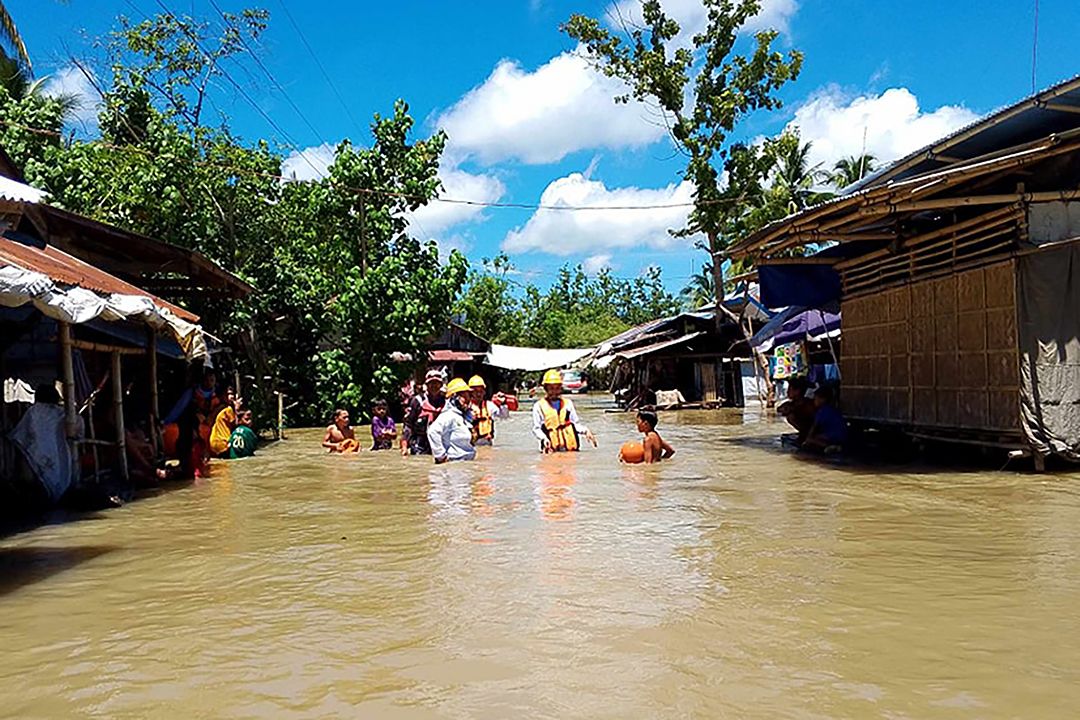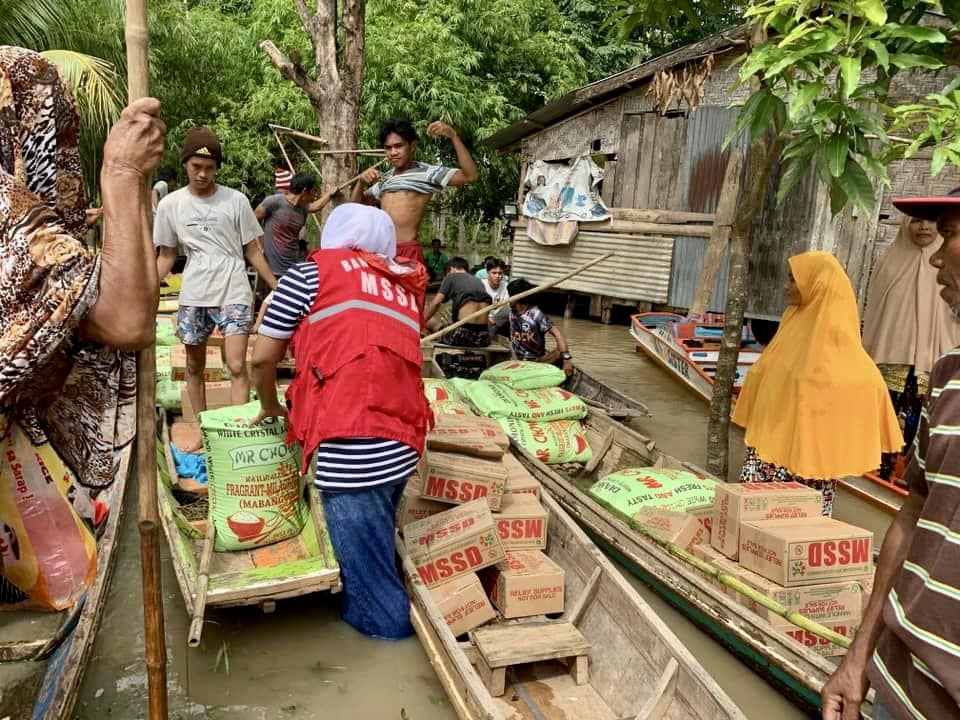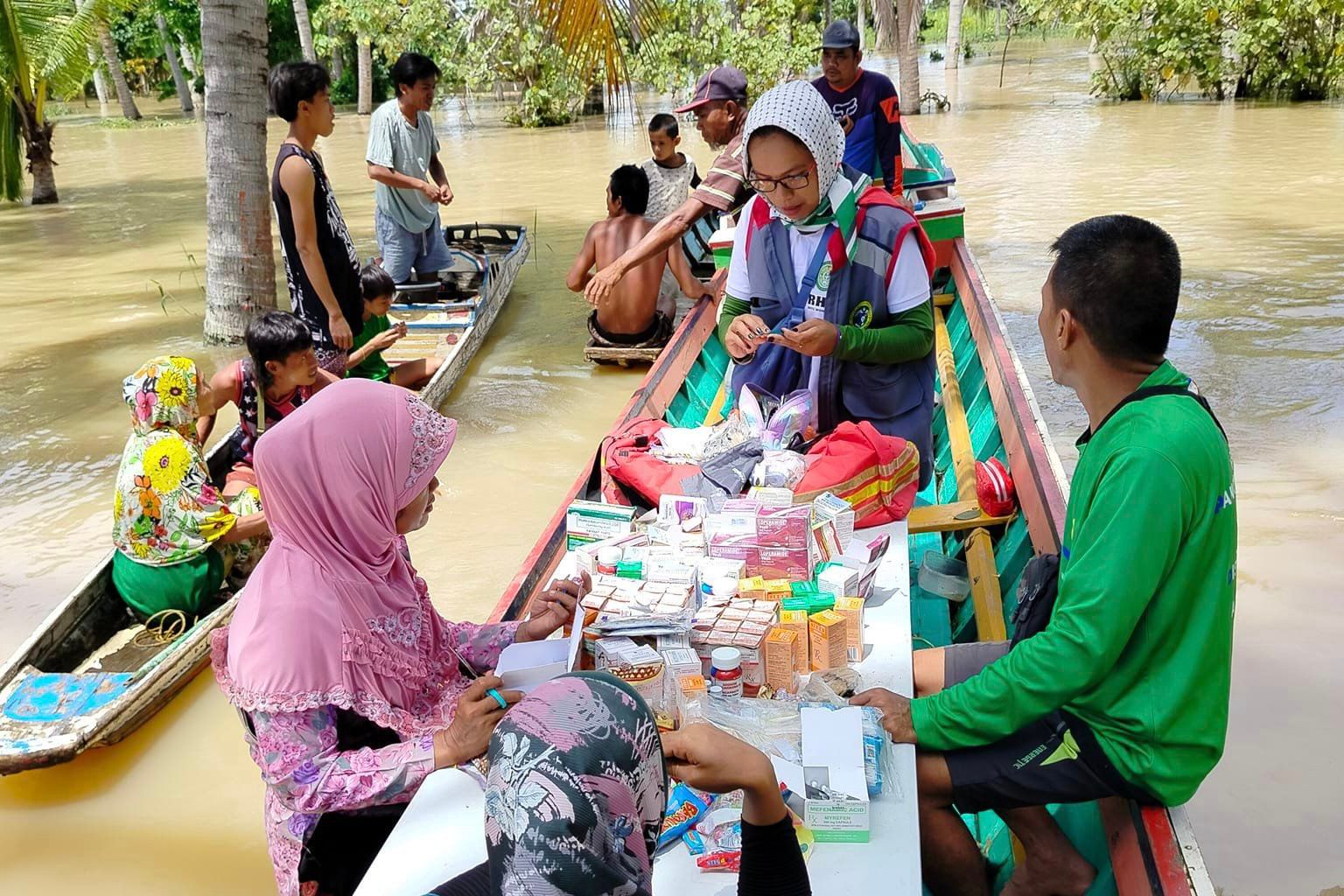DAVAO CITY – From no water to too much water.

PEOPLE wade through floodwater in Sultan sa Barongis, Maguindanao del Sur. (SSB MDRRMO photo)
About five months ago, residents in many parts of Bangsamoro Autonomous Region in Muslim Mindanao (BARMM) provinces were praying for the rains to come as the prolonged dry spell destroyed hundreds of hectares of agricultural crops.
One of the worst-hit provinces in the region was the province of Maguindanao del Sur which was placed under the state of calamity last April due to the impact of the El Niño phenomenon.
But as people were still reeling from the impact of the dry spell, another natural disaster devastated over 8,000 hectares of agricultural land across BARMM due to severe flooding due from heavy rains amid the southwest monsoon or habagat since last week.
A report from the BARMM Rapid Emergency Action on Disaster Incidence (Bangsamoro READi) showed that as of July 18, severe flooding in the region has affected over 135,000 families or about 600,000 persons from the provinces of Basilan, Lanao del Sur, Maguindanao del Norte, Maguindanao del Sur, and Special Geographic Area (SGA).
At least 76,000 of these families were from Maguindanao del Sur which was placed again under a state of calamity on July 16.
The widespread flooding has affected 17 of its 24 towns, according to a report from the provincial government.
Aside from Maguindanao del Sur, the newly-created towns under the BARMM’s SGA were also submerged in floodwaters for almost a week.
Photos and videos of flooding on social media channels showed that vast agricultural lands, houses, government establishments, and schools have been submerged in floodwaters.
In many areas, floodwaters leveled with the roof of several structures as many residents evacuated to safer grounds using canoes and motorized pumpfood aid to remote barangays in Datu Montawal, Maguindanao del Sur.

FOOD aid for flood victims is transported in Datu Montawal, Maguindanao del Sur. (MSSD -BARMM Photo)
Many of these flood-hit areas are located on the banks of the Pulangi River that cuts across several towns of Maguindanao provinces as well as some parts of the province of Cotabato.
The flooding in Central Mindanao was spawned by heavy rains not just in the region but as well as in the mountainous areas of Bukidnon, the headwaters of Pulangi River.
Pulangi River flows down to the sprawling 220,000-hectare Ligawasn Marsh that drains to the Moro Gulf through the Rio Grande de Mindanao.
But aside from the heavy rains, flood-hit communities also blamed the sudden swelling of the Pulangui River to the reported discharge of water from the dam of the Pulangi IV Hydroelectric Power Plant of the National Power Corp. in Maramag, Bukidnon on July 12.
The reported release of water allegedly contributed to the sudden surge of floodwaters in low-lying areas of Central Mindanao.
Cotabato Gov. Emmylou Taliño-Mendoza chided the Napocor for releasing the water without prior notice to the local government units downstream.
The heavy siltation and the volume of water from the mountains in Bukidnon have contributed to the severe flooding in the region, according to Mendoza.
Local government officials in Cotabato have been appealing to the national government to assist in addressing the perennial flooding in Central Mindanao.
The flood-hit areas sit on the Mindanao River Basin which is the second largest river basin in the Philippines with a total area of 21,503-square kilometers and is the second largest river system in the Philippines next to Cagayan River in Luzon.
The entire river system is also the second longest river in the country with an approximate length of 373 kilometers.
Worst flood
While occasional flooding has been a part of the lives for most of the communities on the banks of Pulangui River and Ligawasan Marsh, this current flooding is perhaps the worst.
A member of the barangay council in Barangay Buliok in Pagalungan in Maguindanao del Sur said this flooding could be the worst in the history of his hometown.
"In the past, we have experienced flooding but the water level is only just over knees. But this time, many houses were submerged," Gerald Mamasalagat said.
Mamasalagat recounted that the water breached the banks of Pulangi River at 6 p.m. on July 13.
He added that the floodwaters rose so fast and caught them unprepared. Thus, many residents were not able to evacuate to safer grounds.

A RURAL health unit worker distributes medicines to flood-hit residents of Barangay Talitay, Datu Montawal, Maguindanao del Sur. (LGU Datu Montawal photo)
"Only those with motorized pump boats were able to get out of Buliok. Maybe about 200 of 1,500 families were able to evacuate," the village official lamented.
"Marami dito ang nakikisilong na lang muna sa mga may matataas na bahay. Ang iba naman gumawa na ng paraan na hindi malubog sa baha (Many sought shelter in neighbors with high houses. Other fixed their houses so that they won’t be submerged in flood)," he added.
On July 14 to 15, floodwaters submerged a portion of the Cotabato-Davao National Highway in Pagalungan.
The water, as of posting time, has receded in their village but some areas are still underwater, said Mamasalagat.
"Nahihirapan pa ang mga tao na makabangon sa epekto ng tag-init, tapos ngayon binaha na naman kami (We still have to recover from the effects of the hot weather now we are flooded."
In Sultan da Barongis town, Maguindanao del Sur, about 50 kilometers south of Pagalungan, several barangays are still underwater for almost a week now.
Both towns are among the known flood-prone municipalities since they sit right on the edge of Ligawasan Marsh.
Darampua Elementary School Principal Motin Ukom described that the widespread flooding has turned several villages into an ocean.
"The land has disappeared, it's flooded everywhere," Ukom said. “We are used to flooding here because Darampua is already part of the Ligawasan Marsh but this flooding is the worst.”
Since Sultan sa Barongis is a marshy area, he lamented that most of the residents have nowhere to go.
“Naawa ako sa ibang tao na walang mapupuntahan dahil sa bubong na lng bahay nila natutulog (I pity residents who have nowhere to go and sleeping only on the roof of their houses).”
Most of the affected residents are just staying in their houses, the school official said.
As classes are set to resume on July 29, Ukom is worried on how they can prepare the classrooms since they are still submerged in floods.
He added that they are supposed to kick-off the annual Brigada Eskwela in the region on July 22. "Pero obserbahan muna namin ang tubig (We have to observe the water level first)."
Relief aid needed
Mamasalagat is appealing for relief assistance for his fellow villagers in Buliok a week since the flood hit.
While the Ministry of Social Services and Development (MSSD) has distributed food aid for the affected families, he is worried that the two kilos of rice and other food items that received on July 17 may not last long.
He lamented that many of the residents in the village could not go out and buy or collect any food assistance because the road is still submerged in floodwaters.
The most efficient means to transport the relief assistance to the interior villages of Pagalungan is through motorized pump boats, which is very limited.
In other affected towns along the Ligawasan Marsh, traditional canoes and motorized pump boats are being used to transport relief goods to flood victims in remote areas
On July 18, the MSSD reported that it has distributed food and non-food assistance to approximately 11,179 families affected by flooding.
It added that the aid distribution occurred from July 9 to 16 both within and outside the Bangsamoro territory.
Moreover, MSSD reported that each family received 25 kilograms of rice, along with canned goods, sleeping kits, cooking kits, dignity and protection kits, safe drinking water, and infant kits to meet their basic needs.
“MSSD will provide food packs, tents, wash facilities, and essential kits (sleeping, hygiene, dignity, and infant) through the Disaster Response Management Division to address the victims’ immediate needs,” MSSD Minister Raissa Jajurie said.